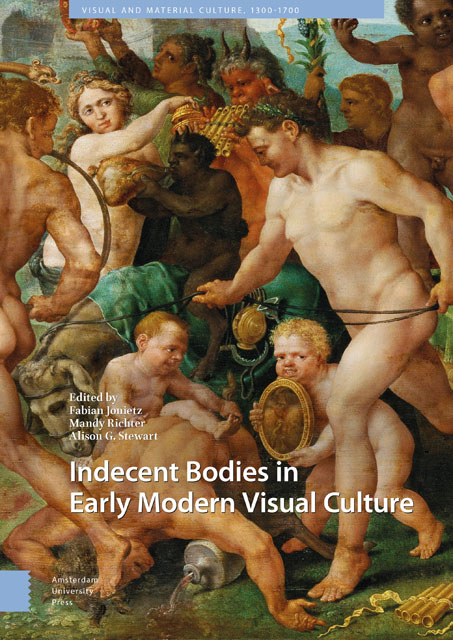Book contents
- Frontmatter
- Table of Contents
- List of Illustrations
- Indecent Bodies in Early Modern Visual Culture: An Introduction
- 1 Taste, Lust, and the Male Body: Sexual Representations in Early Sixteenth-Century Northern Europe
- 2 Private Viewings: The Frankfurt Context of Sebald Beham’s Die Nacht
- 3 To Show or Not to Show? Marcantonio Raimondi and the Representation of Female Pubic Hair
- 4 Treating Bodily Impurities: Skin, Art, and Medicine
- 5 Indecent Exposure and Honourable Uncovering in Renaissance Portraits of Women
- 6 Lust in Translation: Agency, Sexuality, and Gender Configuration in Pauwels Franck’s Allegories of Love
- 7 ‘So this guy walks into a forest…:’ obscenity, humour, sex, and the equine body in hans baldung’s Horses in a forest woodcuts (1534)
- 8 Indecent Creativity and the Tropes of Human Excreta
- 9 ‘It All Turns to Shit’ – The Land of Cockaigne in Sixteenth-Century German Woodcuts
- 10 Noëls and Bodily Fluids: The Business of Low-Country Ceremonial Fountains
- Index
5 - Indecent Exposure and Honourable Uncovering in Renaissance Portraits ofWomen
Published online by Cambridge University Press: 19 April 2023
- Frontmatter
- Table of Contents
- List of Illustrations
- Indecent Bodies in Early Modern Visual Culture: An Introduction
- 1 Taste, Lust, and the Male Body: Sexual Representations in Early Sixteenth-Century Northern Europe
- 2 Private Viewings: The Frankfurt Context of Sebald Beham’s Die Nacht
- 3 To Show or Not to Show? Marcantonio Raimondi and the Representation of Female Pubic Hair
- 4 Treating Bodily Impurities: Skin, Art, and Medicine
- 5 Indecent Exposure and Honourable Uncovering in Renaissance Portraits of Women
- 6 Lust in Translation: Agency, Sexuality, and Gender Configuration in Pauwels Franck’s Allegories of Love
- 7 ‘So this guy walks into a forest…:’ obscenity, humour, sex, and the equine body in hans baldung’s Horses in a forest woodcuts (1534)
- 8 Indecent Creativity and the Tropes of Human Excreta
- 9 ‘It All Turns to Shit’ – The Land of Cockaigne in Sixteenth-Century German Woodcuts
- 10 Noëls and Bodily Fluids: The Business of Low-Country Ceremonial Fountains
- Index
Summary
Abstract
Commissioning portraits of Renaissance women was a more common practicethan is generally imagined. An impressive corpus was produced in Venice,although the sitters’ names are lost. Their identity is furtherclouded by the repetition of similar features, including elaboratelydressed blond hair, and similar luxurious attire. Rather than readingthese elements as an erasure of identity, they can be understood asmarkers of wealth and beauty of individual women within highlyrestrictive codes. Another device introduces partial nudity, which hasbeen interpreted as portrayals of courtesans. Evidence, however, showsthat in many cases the unveiling of a breast functions in the context ofbetrothal and marriage imagery; so far from creating a category of‘Courtesan Portraits’ the nudity, along with othersymbols, establishes iconography pertaining to the chaste sexuality ofvirtuous wives.
Keywords: courtesans in art; betrothal imagery; Early Modernportraits of women; Flora imagery; sexual imagery; Venetian Renaissanceart
Commissioning portraits of women in the Renaissance was a more commonpractice than is generally imagined. Ironically, while a large number ofrepresentations of women comes from the second half of the sixteenth centuryin Venice, this group of paintings has sustained considerable scholarlyargument about its relation to the genre of portraiture. The doubts stemfrom two concerns, which at times are intertwined. The first objectioncentres on the observable fact that the women, almost all unidentified,convey similar features conforming to the narrowly defined standards ofbeauty found in literary topoi. From this it is oftenconcluded that what we have are not portraits of real women, but abstractembodiments of beauty. The second objection is that many of therepresentations exhibit some degree of nudity, with the implicit or statedbelief that this would not be possible for a ‘respectable’woman. This moralising assumption has led to the belief that the womendelineated are prostitutes. I want to problematise both the perceivedabsence of living women and the categories of decent vs. indecent, whichhave been applied to Renaissance representations of women.
Removal of the binary opposition helps to clarify the identity of thesitters, although their names are not recoverable.
- Type
- Chapter
- Information
- Indecent Bodies in Early Modern Visual Culture , pp. 129 - 154Publisher: Amsterdam University PressPrint publication year: 2022



